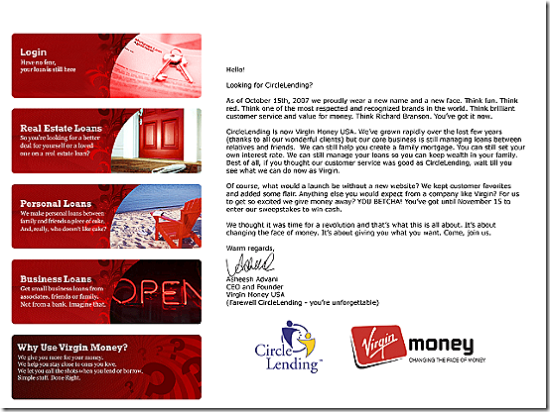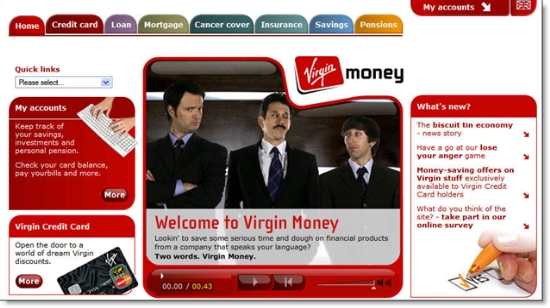 As we enter the final week of summer, we will begin showcasing the companies that will be DEMOing new products and services at our inaugural conference FINOVATE 2007. See here for the complete lineup.
As we enter the final week of summer, we will begin showcasing the companies that will be DEMOing new products and services at our inaugural conference FINOVATE 2007. See here for the complete lineup.
Person-to-person lending
P2P lending has grabbed headlines around the world since it launched in the the United Kingdom in March 2005 by Zopa. We are pleased to have on the FINOVATE agenda the two leading U.S. providers: Prosper, the brain-child of E-Loan founder Chris Larsen, and Lending Club, which launched its exchange on the Facebook platform just three months ago.
Both companies received significant cash infusions this summer and we're looking forward to seeing what enhancements the lenders will showcase at FINOVATE 2007.
 Lending Club received a significant $10.3 million first round last week (blog entry here). Since the company's launch of Facebook three months ago today, it has closed 134 loans averaging approximately $5,600 for a total of $750,000 in originations.
Lending Club received a significant $10.3 million first round last week (blog entry here). Since the company's launch of Facebook three months ago today, it has closed 134 loans averaging approximately $5,600 for a total of $750,000 in originations.

 In June, Prosper, the winner of an OBR Best of the Web award last year (note 1), secured a $20 million third round bringing total funding to $40 million (previous post here). The company now has more than 380,000 members and has funded nearly 14,000 loans totally $80 million. Since inception, Prosper has posted more than 168,000 loan listings from more than 75,000 borrowers.
In June, Prosper, the winner of an OBR Best of the Web award last year (note 1), secured a $20 million third round bringing total funding to $40 million (previous post here). The company now has more than 380,000 members and has funded nearly 14,000 loans totally $80 million. Since inception, Prosper has posted more than 168,000 loan listings from more than 75,000 borrowers.
Mortgage lending
Here's a bit of trivia for Monday afternoon (or Tuesday morning if you read NetBanker via email): What was the first profitable banking website? And no, this is not a trick question with the answer being "none" or "no one knows" (see note 1).
The answer: Bank of America in 1994, or at least that's what an exec told the audience at the first conference on Internet banking held in the summer of 1995. Practically before anyone outside of academia or Silicon Valley had heard of the Web, BofA was using it to produce mortgage leads in the lucrative California market. I can clearly remember the woman who ran BofA's website saying, "mortgage leads are already more than covering the bank's costs (of its website)." Of course, that was in the days when a website cost less than a couple billboards.

 We've been writing about online mortgage lending since that first 1995 conference. One of our favorite lending platforms, winner of the second mortgage-related OBR Best of the Web award in 2001, is MortgageBot. The company was also named to last year's INC 500 list of the nation's fastest growing private companies producing a 560% revenue increase during the YE 2002 through YE 2005 period.
We've been writing about online mortgage lending since that first 1995 conference. One of our favorite lending platforms, winner of the second mortgage-related OBR Best of the Web award in 2001, is MortgageBot. The company was also named to last year's INC 500 list of the nation's fastest growing private companies producing a 560% revenue increase during the YE 2002 through YE 2005 period.
At FINOVATE 2007, MortgageBot will take the stage to show a radical new approach to mortgage shopping that its been testing for some time now. We can't release the details yet, but we were luck enough to get a sneak peek on Friday and were very impressed!
Note:
1. Our sister publication, Online Banking Report (OBR), typically names 6 or 7 companies as "Best of the Web" during the course of each year. It is earned by launching a product or service that significantly "raises the bar" in online delivery of retail banking and lending products.
 Jeff Bezos may have grabbed the cover of Newsweek for the latest high-tech gadget, the Amazon Kindle, but that's old hat for him. The bigger news in online banking circles is Richard Branson gracing the cover of the December/January issue of Fortune Small Business (click on the inset to read the magazine online). His smiling mug is shown tossing hundred-dollar bills out of a teller cage.
Jeff Bezos may have grabbed the cover of Newsweek for the latest high-tech gadget, the Amazon Kindle, but that's old hat for him. The bigger news in online banking circles is Richard Branson gracing the cover of the December/January issue of Fortune Small Business (click on the inset to read the magazine online). His smiling mug is shown tossing hundred-dollar bills out of a teller cage.  The 1.5 page story discusses the Business Builder "friends and family" loans that Virgin will administer for a one-time cost of $199 to $299 plus $9 per payment. The company says it plans to offer a business loan product later in 2008 or 2009 that will match outside money to the original friends and family loan, provided it's been paid on time.
The 1.5 page story discusses the Business Builder "friends and family" loans that Virgin will administer for a one-time cost of $199 to $299 plus $9 per payment. The company says it plans to offer a business loan product later in 2008 or 2009 that will match outside money to the original friends and family loan, provided it's been paid on time. 
























